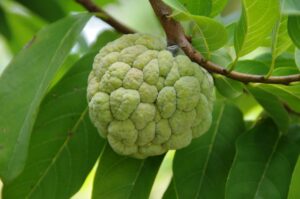B.N. – Annona squamosa
Family – Annonaceae
Ch.No. – 2n = 14
Origin – Tropical America
Fruit type – Eteario of berries (Aggregate fruit)
Edible part – Pericarp
Watch Lecture Video
Important Point
- Bears on axillary on old season growth.
- Maximum production – AP
- Ramphal (Bullock’s heart) Annona reticulata – common rootstock)
- Lakshman phal (Atemoya) – Annona atemoya ( squamosa x A. cherimola)
- Hanuman phal (Cherimoya) – Annona cherimola
- Sour sap (Large Annona) – Annona muricata
- Pond Apple – Annona globra.
- Cherimoya is considered to be the best fruit of the Annonaceae family.
- Cherimoya – Prefer subtropical climate.
- Custard apple contains 20% sugar.
- Bullock’s heart is more commonly found in South India than in North India.
Varieties
- Balanagar
- Barbados seedling
- British Guinea
- Kakarlapahad

Custard Apple - Mahaboobnagar
- Washington
Hybrid
Arka sahan – less no. of seeds (10/100gm w.t.), high brix 310 crosses between A. atemoya x A. squamosa
African pride – Cherimoya x Custard Apple
Soil
- Loamy soils with good water holding capacity, good drainage, and pH between 5.5 to 6.5 are best suited.
Climate
- Custard apple requires a hot dry climate during flowering and high humidity at the time of fruit set.
- Annual rainfall 50 to 75 cm.
- Temperature between 5o to 8o is best for the development of the distinctive taste of custard apple.
- Cherimoya does not tolerate high as well as chilling (low) temperatures but is more tolerant to frost than custard apples. Temperatures between 200C to 300C are ideal for its growth and fruiting.
Propagation
- Propagation is done by seed as well as vegetative methods.
- Propagation by budding or grafting on the seedling rootstock is not very difficult.
- The most commonly adopted method is budding and Inarching.
- budding is performed from June to August or with the onset of monsoon.
- Grafting is mostly done in June-July.
Planting
- Pits of 60 cm3 size are dug at a distance of 4 to 5 m.
- Planting is usually done during the rainy season from July to mid-September.
Training & Pruning
- In the initial stage, the plant is trained by a single stem system otherwise, no training is required.
- Pruning is done in February-March with the onset of new growth.
Manures and fertilizers
- 250:125:125g NPK
- These should be given at the beginning of the rainy season.
Irrigation
- Custard apple is generally grown as a rainfed crop.
- Two to three irrigations at the time of flowering and fruit set in summer and one irrigation at maturity after the rainy season improve fruit quality and yield.
Weed control
- Controlling weeds is essential for good plant health.
- Shallow hoeing during August-September inhibits weed growth.
Intercropping
Legume crops can be grown as an intercrop till the period of full development of the canopy of the plant.
Flowering, pollination, and fruit set
A custard apple tree may produce 1500 – 2000 flowers but hardly 2 to 3% fruit set. This reduced fruit set is due to the lack of pollinating insects, dioecious, high temperature, and low humidity at the time of flowering.
Harvesting
- Seedling plants start fruiting in 4-5 years while grafted or budded plants give fruit in 3-4 years.
- Custard apple is a seasonal fruit and is plucked at the stage of full maturity when the fruit starts turning from green to creamy yellow in colour.
Yield
50-100 fruits/tree
Insect pest
- Mealy Bug – (Ferresia virgata)
- Scale – (Cerophastes floridensis)
- Aphid
- Fruit boring caterpillar (Hetrographics bemgallela)
Disease
- Leaf spot (Cercospora annanea)
- Root Rot (Diplodia natalensis)
